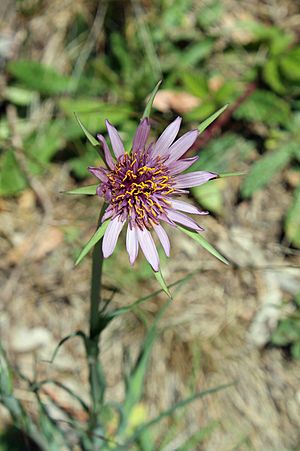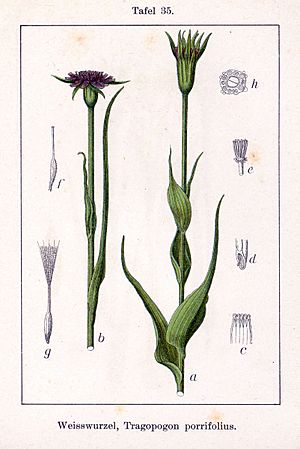Salsify facts for kids
Tragopogon porrifolius is a cool plant known for its pretty purple flowers and its root, which people can eat! You might hear it called purple salsify or common salsify. It also has fun nicknames like oyster plant (because its root tastes a bit like oysters!), vegetable oyster, Jerusalem star, Jack go to bed, or goatsbeard. It's part of the Tragopogon family.
The name porrifolius comes from Latin and means "with leaves like a leek".
Quick facts for kids Salsify |
|
|---|---|
 |
|
| Scientific classification | |
| Genus: |
Tragopogon
|
| Species: |
porrifolius
|
| Synonyms | |
|
|
| Nutritional value per 100 g (3.5 oz) | |
|---|---|
| Energy | 343 kJ (82 kcal) |
|
18.6 g
|
|
| Dietary fiber | 3.3 g |
|
0.2 g
|
|
|
Protein
|
3.3 g
|
| Vitamins | Quantity
%DV†
|
| Thiamine (B1) |
7%
0.08 mg |
| Riboflavin (B2) |
18%
0.22 mg |
| Niacin (B3) |
3%
0.5 mg |
| Pantothenic acid (B5) |
7%
0.371 mg |
| Vitamin B6 |
21%
0.277 mg |
| Folate (B9) |
7%
26 μg |
| Vitamin C |
10%
8 mg |
| Minerals | Quantity
%DV†
|
| Calcium |
6%
60 mg |
| Iron |
5%
0.7 mg |
| Magnesium |
6%
23 mg |
| Manganese |
13%
0.268 mg |
| Phosphorus |
11%
75 mg |
| Potassium |
13%
380 mg |
| Sodium |
1%
20 mg |
| Zinc |
4%
0.38 mg |
| Other constituents | Quantity |
| Water | 77 g |
|
Link to USDA Database entry
|
|
| †Percentages estimated using US recommendations for adults. | |
Contents
Where Does Salsify Grow?
Tragopogon porrifolius is a common wild plant that lives for two years. It originally comes from southern Europe and northern Africa. However, people have brought it to many other places. Now you can find it growing wild in the British Isles, other parts of northern Europe, North America, southern Africa, and Australia. In the United States, it grows in almost every state, except for the very far southeast.
What Does Salsify Look Like?
This plant can grow quite tall, up to about 1.2 meters (4 feet). Like other Tragopogon plants, its main stem usually doesn't have many branches. Its leaves look a bit like grass. If you break the stem, a milky white liquid comes out. The main root, called a taproot, can be 15–30 cm (6–12 inches) long and 2–5 cm (1–2 inches) thick.
Flowers and Seeds
In the UK, salsify flowers from May to September. In warmer places like California, it can bloom as early as April. The flower head is about 5 cm (2 inches) wide. Green leaf-like parts, called bracts, surround each flower head and are longer than the petals. The flowers are a dull purple color and are 3–5 cm (1.2–2 inches) across. These flowers have both male and female parts, and insects help them make seeds by carrying pollen.
The seeds are shaped like rods with light ridges. They have hairs on one end that help the wind carry them away. These seeds are 10–17 mm long and 1–3 mm wide, not counting the long beak, which can be up to 55 mm (about 2 inches) long. When all the seeds are formed, the plant looks like a fluffy ball. This is why it's sometimes called "goatsbeard."
Growing Salsify for Food
The root and young shoots of T. porrifolius can be cooked and eaten. The fresh leaves can also be eaten raw or cooked. People have grown this plant for food for a very long time. Ancient writers like Pliny the Elder even mentioned it!
Growing salsify in Europe started in the 1500s in France and Italy. In the United Kingdom, it was first grown for its pretty flowers. Later, in the 1700s, it became a somewhat popular vegetable, but then its popularity went down. Today, the root is most often grown and eaten in France, Germany, Italy, and Russia. However, another plant called Spanish salsify has become more popular as a farmed crop.
How to Plant Salsify
Salsify is grown much like other root vegetables such as parsnips and carrots. It needs similar care. You can plant the seeds in late summer or early winter for an early start. Planting can also be done in early spring, about 100 days before the first frost. The soil should be well-prepared, ideally a rich, loose soil called loam.
Seeds should be planted 1.3 to 2 cm (about half an inch to three-quarters of an inch) deep. Rows should be about 45 to 60 cm (18 to 24 inches) apart, and seeds should be spaced about 3 cm (1.2 inches) apart within the row. Once the young plants are about 5 cm (2 inches) tall, you need to thin them out so they are about 5 cm apart. This helps the roots grow big and strong.
Salsify needs deep, loose soil that isn't too dry. If the soil is stony or too wet, it can hurt the roots and make harvesting difficult. It's best not to use fresh manure when growing salsify. Making sure the plants get enough water during their main growing period helps prevent the taproot from splitting.
Climate for Salsify
Salsify grows well in areas with a mild climate. The seeds need temperatures between 8–16 °C (46–61 °F) to sprout. The plant can handle cold weather and is not easily damaged by light freezing. It can freeze if temperatures drop below -1.1 to -1.6 °C (30–29 °F).
Life Cycle of Salsify
Salsify is a biennial plant, meaning it lives for two years. In its first year, it mostly grows leaves and stores energy in its root system. In the second year, it grows its purple flowers. These flowers bloom from early to mid-summer.
Harvesting and Storing Salsify
The taproots are usually ready to harvest from late autumn onwards, often after October in the Northern Hemisphere. Many people prefer to harvest them after a frost, as this can improve the taste of the root. Once the plant flowers, the taproot becomes tough and not good to eat.
You can store the roots in traditional outdoor storage areas called clamps. For longer storage, keeping them in a refrigerator at 0 °C (32 °F) with high humidity (90–95%) can keep them fresh for 2–4 months.
Pests and Diseases
Salsify doesn't have many problems with pests or diseases. The most common disease is white rust, caused by a fungus called Albugo tragopogonis. You might see yellow spots on the leaves and stems at first, which then turn into small white blisters.
Sometimes, salsify can get rust diseases caused by other fungi. If the rows are planted too close together, powdery mildew can affect the plants. If you leave the roots in the ground over winter, small animals like mice and voles might nibble on them.
How People Use Salsify
Besides eating the root, a milky liquid from the root can be used to make a kind of chewing gum.
Salsify as Food
The whole plant is edible, but the roots and leaves taste best when picked before the flower stalk grows. The raw root has a mild flavor, often described as tasting like asparagus or oysters. This is why it's called the "oyster plant."
You can scrape off the outer layers of the root and dip it in cold water to keep its color. If the roots are too tough, you can boil them with a pinch of baking soda and change the water. Young raw roots can be grated into salads, but older roots are better cooked. They can be added to soups, stews, or stir-fries. Salsify purée (sometimes mixed with potato) is great with fish.
The flowering shoots can be cooked or eaten raw, just like asparagus. The flowers can be added to salads, and sprouted seeds can be used in salads or sandwiches.
Raw salsify is mostly water (77%), with some carbohydrates (19%) and protein (3%). It has very little fat. A 100-gram serving of raw salsify has 82 calories and provides good amounts of riboflavin, vitamin B6, vitamin C, manganese, and phosphorus.
Images for kids
See also
 In Spanish: Tragopogon porrifolius para niños
In Spanish: Tragopogon porrifolius para niños




